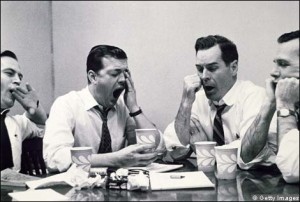YAWNING
XI. Neuromuscular Production of Yawns
A. ACh secreted from hypoglossal motor neuron projecting from the ventral horn
1. C1-3 spinal cord
a. to geniohyoid muscles
2. may be inhibited by spinal GABA interneurons
a. acting on GABAA receptors
B. ACh binds to Nicotinic receptors at a neuromuscular synapse
1. stumulates action potential (= end-plate potential or EPP)
2. Opening transmitter-gated Na+, Ca++ and K+ channel
(a large diameter channel)
a. EPP passes along sarcolemma and into transverse tubules
i. opens voltage gated Ca++ channels in
sarcoplasmic reticulum
(1) binds to troponin
(a) conformational change in tropomyosin
uncovers binding site for myosin on actin
(i) myosin binds to actin
(ii) conformational change
(muscle contracts)
(iii) ATP allows unbinding of actin
ii. Ca++ATPase returns Ca++ to cisternae
of sarcoplasmic reticulum
C. Role of other transmitter systems
1. Transmitter-Receptor systems with Ca++ 2nd messengers
ö DG Þ PKC
a. GpÞPLC ÞPIP2 ÞIP3 ÞCa++
i. OT/OT-R, AVP/V1A, NE/a1
2. directly stimulates the contraction of smooth muscle systems
a. uterus, vas deferens, mammary alveolar ducts
blood vessels
b. can it effect striatal muscle directly?
3. Indirect activation of muscle contraction
a. presynaptic activation of motor ACh release
i. Ca++ dependent
D. Useful Movement: contraction of genioglossus, geniohyoid, sternothyroid
followed by contraction of diaphragm and intercostals
1. Contractile force summates for each muscle cell
a. requires repeated EPP's (before fiber relaxes)
i. \requires Ca++ restoration to cisternae
ii. \contractile force depends on initial length
2. the Nervous System Grades the force of muscle contraction
a. single motor axon innervates a single muscle fiber (cell)
b. one motor neuron (many axons) innervates a number of muscle
fibers = Motor Unit
i. smallest functional unit
(1) magnitude of contractile function depends on
innervation ratio (fibers/neuron)
c. graded force is dependent upon motor unit recruitment
d. motor units are recruited in a fixed order
i. weakest to strongest
(1) allows fine motor actions
ii. builds through Yawning
(1) genioglossus, geniohyoid, sternothyroid contract
build during initial phase of yawning
(2) acme phase: ramping up
contraction of diaphragm and intercostals
e. ñ firing rate ñ force
i. more effective summation (see C 1)
XII. Integration of Yawn Circuitry and Behavior
